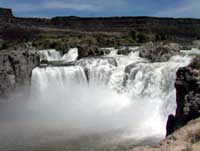|

Shoshone Falls
P.O. Box 1907
Twin Falls, ID 83303
Phone: (208) 736-2265
The Shoshone Indians used to catch salmon at the foot
of Shoshone Falls. The 212-foot cataract was much too high and steep
for the ocean-going fish, so this was the eastern terminus in the Snake
River for migrating salmon. Located just outside the town of Twin Falls,
Shoshone Falls is the largest and most dramatic of all the waterfalls
on the Snake. At least, it is in some years...
Shoshone Falls is such a spectacular work of nature that the entrepreneurs
who settled the Twin Falls region of Idaho disputed which of two industries
to promote: irrigated agriculture or tourism. To divert upstream water
for irrigation would diminish the falls. To preserve the falls for tourists
would foreclose agricultural expansion.
A lawsuit and court judgement settled the matter in favor of the irrigators
in 1902. Thoughts of making Shoshone Falls a national park died away,
and the phrase "Niagara of the West," which had drawn Oregon
Trail travelers to detour slightly for a look at the falls, is no longer
much heard.
Nevertheless, the cataract displays its magnificence during certain
high-water years when the "mad" Snake River runs as high and
wild as ever. Shoshone Indians called the falls "hurling waters
leaping." The river plunges 212 feet over vertical rock ledges
in a thundering roar--a longer fall, indeed, than that of Niagara.
The horseshoe rim is a thousand feet wide. The spray practically creates
its own weather. Shoshone Falls produces hydroelectric power for Idaho
Power Company. Ira B. Perrine, an extraordinary pioneer of Idaho, imagined
the possibility of diverting part of the river through a vertical tunnel
carved in the solid rock. He began excavating in 1901, making progress
intermittently depending on his supply of funds. By 1906 he was building
a power house.
The nearest railroad was thirty miles north. Machinery and supplies
came via horse- drawn wagons from the station across the desert, down
a canyon road to a lava rock ledge, and finally to the construction
site. In August 1907, the town of Twin Falls celebrated its sudden abundance
of power from the finished 500-kilowatt plant by keeping their electric
lights on long past midnight.
Soon the Twin Falls city council created a park on the south bank of
the river at the best place for viewing the grand scene. The town celebrated
Flag Day there, the Grand Army of the Republic had reunions there. In
1928, the town and Idaho Power erected a bank of flood lamps using 25
million candlepower to light the falls at night. In World War II, the
lights were turned off "for the duration" to simplify blackout
planning.
Today, people all over southern Idaho pay attention in the spring.
If Snake River is "leaping," it's worth a two-hundred mile
drive and a picnic lunch to see Shoshone Falls and be amazed.
Hours Season: All Year
Hours: 7:00 a.m. to 9:00 p.m.
Admission
Fees: $3 per car, $20 per bus Annual permits are available for $25 at Twin Falls City Hall or the City Parks & Recreation Office Communities and Related Links
|